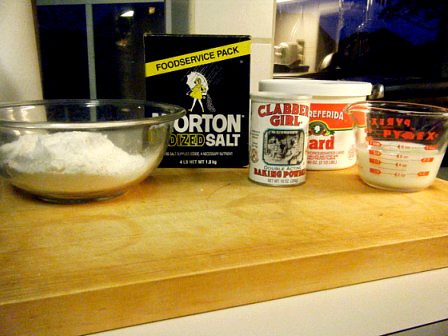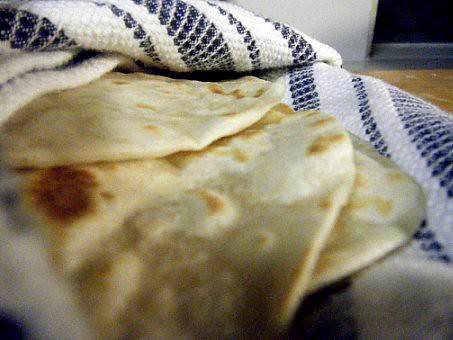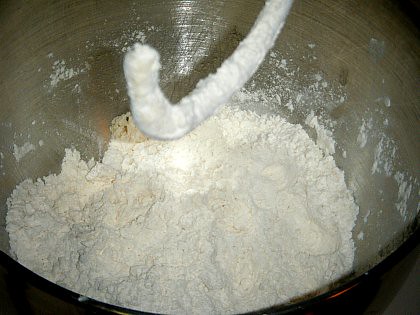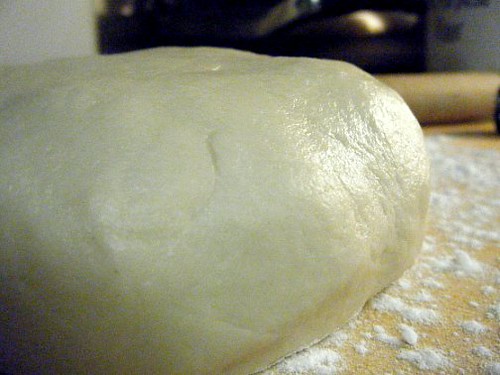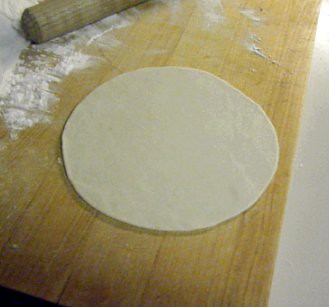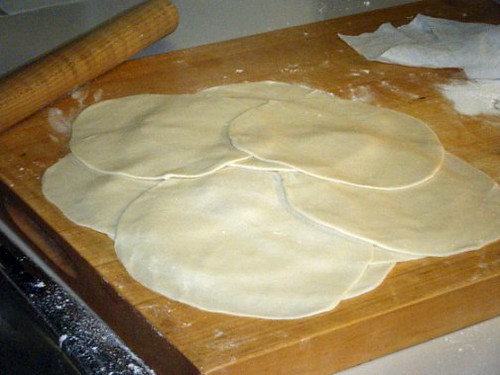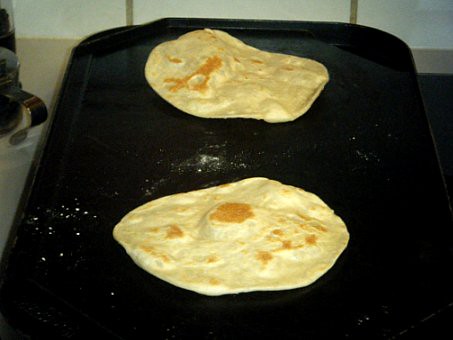Well, if I had had my druthers, I would have been in San Diego for the meet. After all, I was in Ensenada, which is pretty close. Compared to Kansas City, that is. But, no, I couldn’t get away from work for a fun Saturday with other TFL-ers.
Being in Mexico so much in the past few months has had an upside, though. That would be tortillas. Not the stiff, cold, nearly tasteless disks of flour or corn from your supermarket shelves or coolers. Uh-uh. No, we’re talking about steaming, burn-your-fingertips-hot, still puffy, straight-off-the-comal fresh tortillas here. The real deal.
I’ve had freshly made tortillas before. We lived in Houston for five years and there are a bunch of restaurants in that town where you can find fresh tortillas, although they are usually the flour variety. I’ve even made my own, although I haven’t really mastered these deceptively simple little flat breads.
What I’m finding here in the Baja is something almost magical. Whether rolled up to eat as a bread, or torn off in chunks to pick up food, or wrapped around meat and other fillings, tortillas make a simple meal complete in very much the same way a crusty bread makes a bowl of soup a dining experience.
Growing up in northern Michigan really didn’t give me any useful insights into tortillas. The only thing that I knew about tortillas was that they came in boxes (think Lawrys or Old El Paso), were hard, brittle, made of a coarse corn meal and used to make tacos. And that they disintegrated at the first bite. And I wondered: why would anybody get excited about something that lets you take just one bite before it collapses into your lap? Later on I learned about flour tortillas and things like burritos and enchiladas; then tortillas began to make a bit more sense.
But here, as I am sure is the case in other parts of Mexico, tortillas aren’t just an ingredient that you use in one dish of your meal. Instead, they are an integral part of nearly every meal. And that is a very good thing. Especially the maiz (corn) tortillas. They are just as soft and flexible as their flour brethren and come in a variety of sizes. The flour tortillas don’t hold a candle to the maiz tortillas when it comes to taste, though.
For instance, there is a tiny little eatery called Paola’s in the village of La Mision, about half a mile east of Highway 1D along the Baja coast. There are maybe 4 or 5 tables, each seating a handful of diners. You walk up to the counter and you can see the stove, which usually has 5 or 6 large kettles and pans on it. There’s usually beef in one pot, pork in another, chicken in a third and, sometimes, a fourth with lamb, or goat, or tongue or whatever else Paola found at the market that morning. There will also be a pan of beans, usually, though not always, refried; and another of rice. You tell the ladies which meat you want (which is usually braised or stewed with chilies, onions and/or other vegetables) and they will ask “Maiz o harina?” (Corn or flour?) You reply with your choice of tortilla, then tell them what you want to drink and go sit at your table. In a few minutes, your plate will arrive, along with a basket of tortillas that are simply too hot to pick up.
Once the tortillas cool just enough that you can snatch one out of the basket without burning yourself, you have an important decision to make. Should you skip the silverware and use the tortillas to scoop up your food? Should you start stuffing the meat into your tortilla for an impromptu taco? Or just alternate bites of the meat and tortilla so that you get to experience the melding of flavors? In the end, it really doesn’t matter, so long as you savor the flavors that are completed and balanced by the inclusion of the tortillas.
Another favorite dish in these parts is the fish taco. Ensenada is home to a fishing fleet, so you can get fresh fish every day, ranging from sea bass to tuna to squid to lobsters to shrimp. Fish tacos are usually made with white-fleshed fish, like locally caught flounder or halibut. The flesh is cut into strips that are battered and deep fried. A few pieces go into a soft tortilla, preferably a maiz tortilla. They are then topped with shredded lettuce or cabbage. If cabbage, it’s more like a slaw with a faintly sweet-tart creamy dressing. Other than maybe squeezing a lime over it for some extra zing, all you have to do is roll the taco closed and enjoy every bite. All of which would be impossible if not for the tortilla.
While sitting in a restaurant waiting for my check one evening, I saw a woman walk into a work area and haul out a very large stainless steel bowl. She proceeded to scoop several pounds of flour into the bowl from a large bin, then added a largish blob of either shortening or lard, some salt and part of a pitcher of water. She then began to mix it all together with her hands (I wonder if there is a Spanish equivalent for frissage?) until she had a large mass of dough, adding water to get the consistency just right. After rubbing off the excess dough clinging to her hands, she set about rolling the dough into balls that were sized somewhere between a large egg and a tennis ball. About that time, my server brought my check, so I didn’t get to see her finish the process. I’m assuming that, since these were flour tortillas and she was making a large number of them, she probably used a press to flatten the balls into disks which were then put on a griddle to cook. However, I was walking out the door before she got to that stage. Still, it was interesting to see that the tortillas I had enjoyed with my meal were freshly made on site.
Tortillas are sometimes used to thicken soups, or as garnishes. And, yes, they can even be bent and fried into a crispy shell for tacos or salads, although I haven’t seen that in this part of Mexico. For my tastes, though, the tortilla is at its absolute best in its simplest and freshest form. Then it can work its magic in any way the diner desires.




